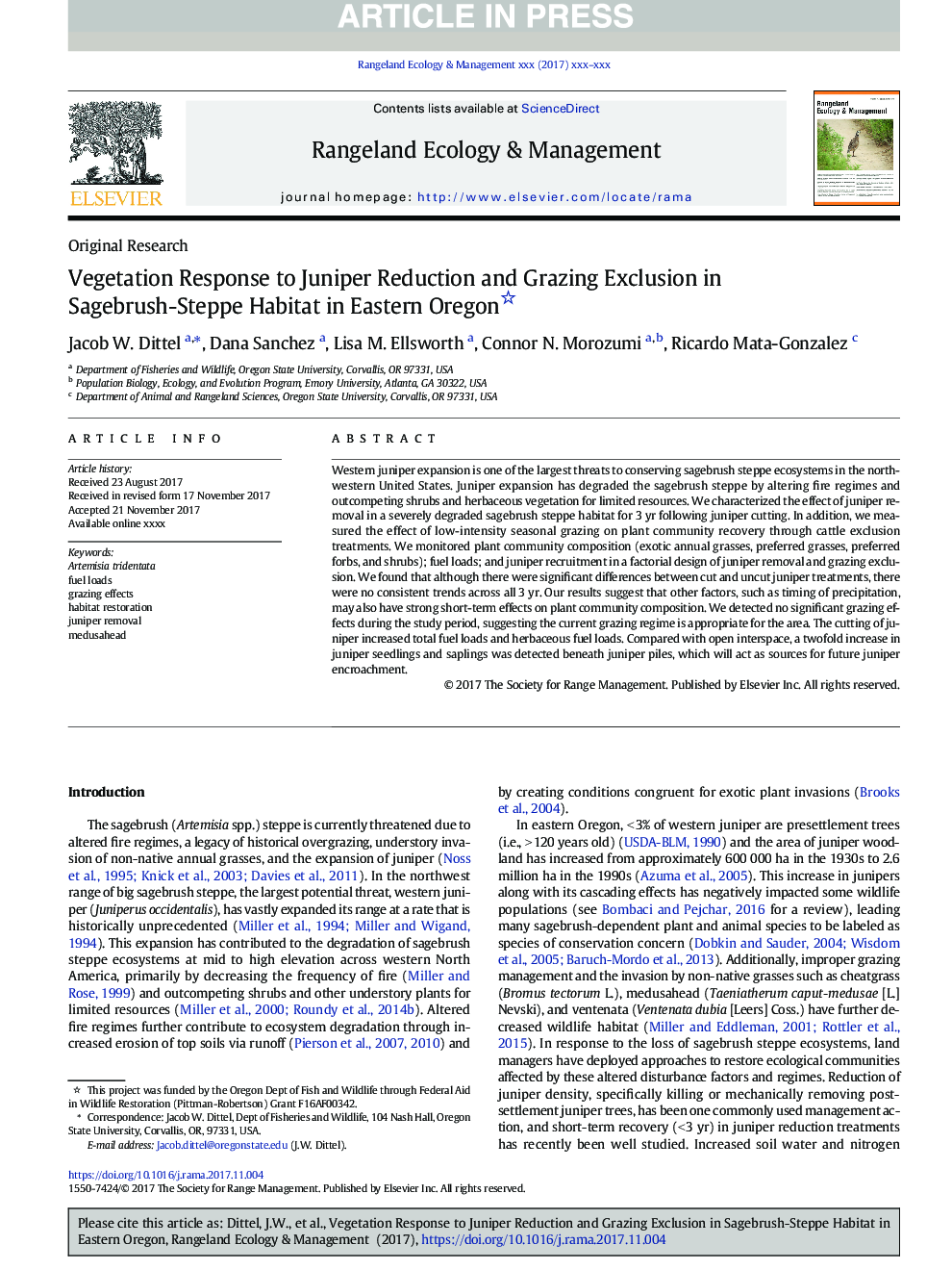| کد مقاله | کد نشریه | سال انتشار | مقاله انگلیسی | نسخه تمام متن |
|---|---|---|---|---|
| 8849628 | 1618645 | 2018 | 7 صفحه PDF | دانلود رایگان |
عنوان انگلیسی مقاله ISI
Vegetation Response to Juniper Reduction and Grazing Exclusion in Sagebrush-Steppe Habitat in Eastern Oregon
ترجمه فارسی عنوان
پاسخ گیاهی به حذف ساقه ها و خروج گاو در ساجباس-استاپ در اورگان شرقی
دانلود مقاله + سفارش ترجمه
دانلود مقاله ISI انگلیسی
رایگان برای ایرانیان
کلمات کلیدی
ترجمه چکیده
گسترش جنگلهای جنگلی یکی از بزرگترین تهدیدات برای حفاظت از اکوسیستم استپ سگبرش در شمال غربی ایالات متحده است. توسعۀ کاشت درختان با استفاده از تغییر رژیم های آتش سوزی و کاشت درختان و گیاهان علفی برای منابع محدود، سبب کاهش استحکام می شود. ما مشخص شد که اثر برداشتن پناهگاه در یک زیستگاه استپ سگ شکسته به شدت کاهش یافته است. علاوه بر این، ما تاثیر چرای فصلی کم شدت را در بهبود بخشیدن به جامعه گیاه از طریق تلقیح گاوها اندازه گیری کردیم. ما ترکیب جامعه گیاهی (چمنزارهای عجیب و غریب، گیاهان ترجیح داده شده، انگورهای ترجیحی و بوته ها) را کنترل کردیم. بارهای سوخت و استخراج پناهگاه در یک طرح فاکتوریل از حذف پنجه فرنگی و خروج از چراگاه. ما دریافتیم که با وجود تفاوتهای قابل توجهی بین روشهای برش و برش نعناع وجود دارد، در طول 3 سال هیچ روند سازگار وجود نداشت. نتایج ما نشان می دهد که عوامل دیگر، مانند زمان رسیدن بارش، همچنین ممکن است اثرات کوتاه مدت بر ترکیب ترکیب گیاهی داشته باشند. ما در طول دوره مطالعه هیچ اثرات قابل ملاحظه ای برای چرت زدن مشخص نکردیم، که نشان می دهد که رژیم فعلی چرا برای این منطقه مناسب است. برش صنوبر، بارهای کل سوخت و بارهای گیاهان سبز را افزایش داد. در مقایسه با فضای باز، افزایش دو برابر درختان نهال و نهال منجنیق زیر زیر شمشیرهای فرعی نشان داده شده است که به عنوان منابع برای تداخل جنگل های آینده ی جنگنده عمل می کند.
موضوعات مرتبط
علوم زیستی و بیوفناوری
علوم کشاورزی و بیولوژیک
علوم کشاورزی و بیولوژیک (عمومی)
چکیده انگلیسی
Western juniper expansion is one of the largest threats to conserving sagebrush steppe ecosystems in the northwestern United States. Juniper expansion has degraded the sagebrush steppe by altering fire regimes and outcompeting shrubs and herbaceous vegetation for limited resources. We characterized the effect of juniper removal in a severely degraded sagebrush steppe habitat for 3 yr following juniper cutting. In addition, we measured the effect of low-intensity seasonal grazing on plant community recovery through cattle exclusion treatments. We monitored plant community composition (exotic annual grasses, preferred grasses, preferred forbs, and shrubs); fuel loads; and juniper recruitment in a factorial design of juniper removal and grazing exclusion. We found that although there were significant differences between cut and uncut juniper treatments, there were no consistent trends across all 3 yr. Our results suggest that other factors, such as timing of precipitation, may also have strong short-term effects on plant community composition. We detected no significant grazing effects during the study period, suggesting the current grazing regime is appropriate for the area. The cutting of juniper increased total fuel loads and herbaceous fuel loads. Compared with open interspace, a twofold increase in juniper seedlings and saplings was detected beneath juniper piles, which will act as sources for future juniper encroachment.
ناشر
Database: Elsevier - ScienceDirect (ساینس دایرکت)
Journal: Rangeland Ecology & Management - Volume 71, Issue 2, March 2018, Pages 213-219
Journal: Rangeland Ecology & Management - Volume 71, Issue 2, March 2018, Pages 213-219
نویسندگان
Jacob W. Dittel, Dana Sanchez, Lisa M. Ellsworth, Connor N. Morozumi, Ricardo Mata-Gonzalez,
